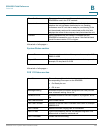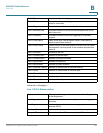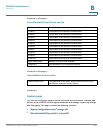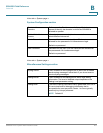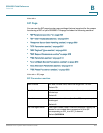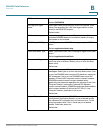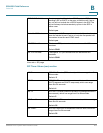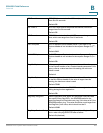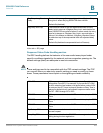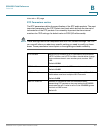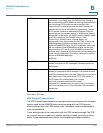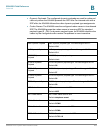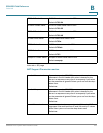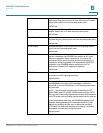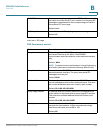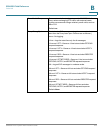
SPA9000 Field Reference
Voice tab
SPA9000 Voice System Administration Guide 206
B
Voice tab > SIP page
Response Status Code Handling section
The RSC handling defines the behavior of the user audio tones played under
specific conditions signaled by the network, such as congestion, queuing, etc. The
default settings (blank) are adequate is most circumstances.
NOTE These settings need to be compatible with the ITSP network settings. The ITSP
you use will inform you about any specific setting you need to modify on these
areas. These parameters have impact on the signaling and audio reliability.
Reg Retry Long Random
Delay
Random delay range (in seconds) to add to <Register Retry
Long Intvl> when retrying REGSITER after a failure.
Default: 0 (disabled)
Reg Retry Intvl Cap The maximum value to cap the exponential back-off retry
delay (which starts at <Register Retry Intvl> and doubles on
every REGISTER retry after a failure). In other words, the retry
interval is always at <Register Retry Intvl> seconds after a
failure. If this feature is enabled, <Reg Retry Random Delay>
is added on top of the exponential back-off adjusted delay
value.
Default: 0 (disables the exponential back-off feature)
SIT1 RSC SIP response status code for the appropriate Special
Information Tone (SIT). For example, if you set the SIT1 RSC
to 404, when the user makes a call and a failure code of 404
is returned, the SIT1 tone is played. Reorder or Busy Tone is
played by default for all unsuccessful response status code
for SIT 1 RSC through SIT 4 RSC.
SIT2 RSC SIP response status code to INVITE on which to play the SIT2
To ne .
SIT3 RSC SIP response status code to INVITE on which to play the SIT3
To ne .
SIT4 RSC SIP response status code to INVITE on which to play the SIT4
To ne .
Try Backup RSC SIP response code that retries a backup server for the
current request.
Retry Reg RSC Interval to wait before the SPA9000 retries registration after
failing during the last registration.



